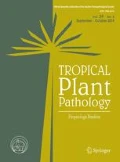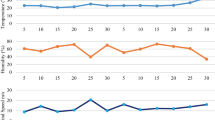Abstract
Decline and death of young vines is a worldwide problem for viticulture that may lead to economic loss. Fungal pathogens have been associated with trunk and root diseases, including the black foot disease that affects the performance of the vineyards. Fungicides have not worked efficiently to control the disease and alternative methods should be investigated. We evaluated the potential of Bacillus subtilis strain F62 for controlling the disease caused by different strains in grapevine rootstocks 1103P (Vitis berlandieri × V. rupestris) and SO4 (V. berlandieri × V. riparia). The in vitro antagonism of B. subtilis F62 was evaluated on mycelial growth, by diffusible and volatile compounds, and conidia germination, by bacterial suspension and cell-free filtrate. In the in vivo assay, cuttings and micropropagated rootstocks were submitted to four different treatments: control, Bac (B. subtilis inoculation), Pat (pathogen inoculation) and Bac + Pat. According to our results, the bioagent was able to inhibit the mycelial growth of all the three fungal isolates by diffusible compounds and conidial germination by bacterial suspension and cell-free filtrate. In the in vivo assay, cuttings of SO4 treated with B. subtilis F62 showed higher shoot nodes and length of primary shoot, while cuttings of 1103P had a longer primary shoot. In micropropagated plants, B. subtilis F62 promoted plant growth in both rootstocks and reduced the frequency of D. macrodidyma re-isolation to 24.6% in SO4 and 29.5% in 1103P. The results demonstrated the potential of B. subtilis F62 on plant growth promotion and in the biocontrol of black foot disease on micropropagated plants and cuttings of grapevine rootstocks 1103P and SO4.

Similar content being viewed by others
References
Abreo E, Martinez S, Bettucci L, Lupo S (2010) Morphological and molecular characterization of Campylocarpon and Cylindrocarpon spp. associated with black foot disease of grapevines in Uruguay. Australasian Plant Pathology 39:446–452
Agustí-Brisach C, Armengol J (2013) Black-foot disease of grapevine: an update on taxonomy, epidemiology and management strategies. Phytopathologia Mediterranea 52:245–261
Ahemad M, Kibret M (2014) Mechanisms and applications of plant growth promoting rhizobacteria: current perspective. Journal of King Saud University - Science 26:1–20
Akram W, Anjum T (2011) Quantitative changes in defense system of tomato induced by two strains of Bacillus against Fusarium wilt. ndian Journal of Fundamental and Applied Life Sciences 1:7–13
Alfonzo A, Conigliaro G, Torta L, Burruano S, Moschetti G (2009) Antagonism of Bacillus subtilis strain AG1 against vine wood fungal pathogens. Phytopathologia Mediterranea 48:155–158
Aroca A, Gramaje D, Armengol J, García-Jiménez J, Raposo R (2010) Evaluation of grapevine nursery process as a source of Phaeoacremonium spp. and Phaeomoniella chlamydospora and occurrence of trunk disease pathogens in rootstock mother vines in Spain. European Journal of Plant Pathology 126:165–174
Baumgartner K, Warnock AE (2006) A soil inoculant inhibits Armillaria mellea in vitro and improves productivity of grapevines with root disease. Plant Disease 90:439–444
Benitez LB, Velho RV, Lisboa MP, Medina LF, Brandeli A (2010) Isolation and characterization of antifungal peptides produced by Bacillus amyloliquefaciens LBM5006. Journal of Microbiology 48:791–797
Berlanas C, López-Manzanares B, Gramaje D (2017) Estimation of viable propagules of black-foot disease pathogens in grapevine cultivated soils and their relation to production systems and soil properties. Plant Soil 417:467–479
Bleach C, Jones E, Ridgway H, Jaspers M (2013) Hot water treatment to reduce incidence of black foot pathogens in young grapevines grown in cool climates. Phytopathologia Mediterranea 52:347–358
Boubakri H, Hadj-Brahim A, Schmitt C, Soustre-Gacougnolle I, Mliki A (2015) Biocontrol potential of chenodeoxycholic acid (CDCA) and endophytic Bacillus subtilis strains against the most destructive grapevine pathogens. New Zealand Journal of Crop and Horticultural Science 4:261–274
Cao Y, Xu Z, Ling N, Yuan Y, Yang X, Chen L, Shen B, Shen Q (2012) Isolation and identification of lipopeptides produced by B. subtilis SQR 9 for suppressing Fusarium wilt of cucumber. Scientia Horticulturae 135:32–39
Chaurasia B, PandeyA PLMS, Trivedi P, Kumar B, Colvin N (2005) Diffusible and volatile compounds produced by antagonistic Bacillus subtilis strain cause structural deformations in pathogenic fungi in vitro. Microbiological Research 160:75–81
Compant S, Clement C, Sessitsch A (2010) Plant growth promoting bacteria in the rhizo and endosphere of plants. Their role, colonization, mechanisms involved and prospects for utilization. Soil Biology and Biochemistry 42:669–678
Ferreira JHS, Matthee FN, Thomas AC (1991) Biological control of Eutypa lata on grapevine by antagonistic strain of Bacillus subtilis. Phytopathology 81:283–287
Furuya S, Mochizuki M, Aoki Y, Kobayashi H, Takayanagi T, Shimizu M, Suzuki S (2011) Isolation and characterization of Bacillus subtilis KS1 for the biocontrol of grapevine fungal diseases. Biocontrol Science and Technology 21:705–720
Garrido LR, Sônego OR, Gomes VN (2004) Fungos associados com odeclínio e morte de videiras no estado do Rio Grande do Sul. Fitopatologia Brasileira 29:322–324
Gong Q, Zhang C, Lu F, Zhao H, Bie X, Lu Z (2014) Identification of bacillomycin D from Bacillus subtilis fmbJ and its inhibition effects against Aspergillus flavus. Food Control 36:8–14
Gramaje D, Armengol J (2011) Fungal trunk pathogens in the grapevine propagation process: potential inoculum sources, detection, identification, and management strategies. Plant Disease 95:1040–1055
Gramaje D, Alaniz S, Abad-Campos P, García-Jiménez J, Armengol J (2016) Evaluation of grapevine rootstock against soilborne pathogens associated with trunk diseases. Acta Horticulturae 1136:245–250
Gramaje D, Úrbez-Torres JR, Sosnowski MR (2018) Managing grapevine trunk diseases with respect to etiology and epidemiology: current strategies and future prospects. Plant Disease 102:12–39
Gupta V, Bochow H, Dolej S (2000) Plant growth-promoting Bacillus subtilis strain as potential inducer of systemic resistance in tomato against Fusarium wilt. Journal of Plant Diseases and Protection 107:145–154
Haichar FZ, Marol C, Berge O, Rangel-Castro JI, Prosser JI, Balesdent J, Heulin T, Achouak W (2008) Plant host habitat and root exudates shape soil bacterial community structure. ISME Journal 2:1221–1230
Halleen F, Fourie PH (2016) An integrated strategy for the proactive management of grapevine trunk disease pathogen infections in grapevine nurseries. South African Journal for Enology and Viticulture 37:104–114
Iniguez AL, Dong Y, Carter HD, Ahmer BMM, Stone JM, Triplett EW (2005) Regulation of enteric endophytic bacterial colonization by plant defenses. Molecular Plant-Microbe Interactions 18:169–178
Jang Y, Kim SG, Kim YH (2011) Biocontrol efficacies of Bacillus species against Cylindrocarpon desctructans causing ginseng root rot. The Plant Pathology Journal 27:333–341
Kejela T, Thakkar VR, Patel RR (2017) A novel strain of Pseudomonas inhibits Colletotrichum gloeosporioides and Fusarium oxysporum infections and promotes germination of coffee. Rhizosphere 4:9–15
Kotze C, Van Niekerk J, Mostert L, Halleen F, Fourie P (2011) Evaluation of biocontrol agents for grapevine pruning wound protection against trunk pathogen infection. Phytopathologia Mediterranea 50:S247–S263
Lopez-Valdez F, Fernandez-Luqueno F, Ceballos-Ramírez J (2011) A strain of Bacillus subtilis stimulates sunflower growth (Helianthus annuus L.) temporarily. Scientia Horticulturae 128:499–505
Lugtenberg B, Kamilova F (2009) Plant growth promoting rhizobacteria. Annual Review of Microbiology 63:541–556
Murashige T, Skoog FA (1962) A revised medium for a rapid growth and bioassays with tobacco tissues cultures. Journal of Plant Physiology 15:473–479
Nain ML, Yadav RC, Saxena J (2012) Characterization of multifaceted Bacillus sp. RM-2 for its use as plant growth promoting bioinoculant for crops grown in semi-arid deserts. Applied Soil Ecology 59:124–135
Oliveira TAS, Blum LEB, Duarte EAA, Moreira ZPM, Luz EDMN (2016) Variability of aggressiveness and virulence of Phytophthora palmivora influencing the severity of papaya fruit rot in postharvest in Bahia, Brazil. Científica 44:185–195
Ollat N, Bordenave L, Tandonnet JP, Boursiquot JM, Marguerit E (2016) Grapevine rootstocks: origin and perspectives. Acta Horticulturae 1136:11–22
Rezgui A, Ben Ghnaya-Chakroun A, Vallance J, Bruez E, Hajlaoui MR, Sadfi-Zouaoui N, Rey P (2016) Endophytic bacteria with antagonistic traits inhabit the wood tissues of grapevines from Tunisian vineyards. Biological Control 99:28–37
Romero D, Vicente A, Rakotoaly RH, Dufour SE, Veening JW, Arrebola E, Cazorla FM, Kuipers OP, Paquot M, Perez-Garcia A (2007) The iturin and fengycin families of lipopeptides are key factors in antagonism of Bacillus subtilis toward Podosphaera fusca. Molecular Plant-Microbe Interactions 20:430–440
Santos RF, Durigon MR, Blume E (2015) Aggressiveness of Ilyonectria spp. and Cylindrocarpon pauciseptatum associated with black foot disease of grapevine. Revista Brasileira de Ciências Agrárias 10:49–53
Santos RF, Heckler LI, Lazarotto M, Garrido LR, Rego C, Blume E (2016) Trichoderma spp. and Bacillus subtilis for control of Dactylonectria macrodidyma in grapevine. Phytopathologia Mediterranea 55:293–300
Shafi J, Tian H, Ji M (2017) Bacillus species as versatile weapons for plant pathogens: a review. Biotechnology and Biotechnological Equipment 31:446–459
Sotoyama K, Akutsu K, Nakajima M (2016) Biological control of Fusarium wilt by Bacillus amyloliquefaciens IUMC7 isolated from mushroom compost. Journal of General Plant Pathology 82:105–109
Sterky F, Lundeberg J (2000) Sequence analysis of genes and genomes. Journal of Biotechnology 76:1–31
Waite H, Whitelaw-Weckert M, Torley P (2015) Grapevine propagation:principles and methods for the production of high-quality grapevine plant material. New Zealand Journal of Crop and Horticultural Science 43:144–161
Wicaksono WA, Jones EE, Mon J, Ridgway HJ (2017) Using bacterial endophytes from a New Zealand native medicinal plant for control of grapevine trunk diseases. Biological Control 114:65–72
Zahir ZA, Arshad M, Frankenberger WT (2003) Plant growth promoting Rhizobacteria: applications and perspectives in agriculture. Advances in Agronomy 81:97–168
Zhao X, Zhou Z-J, Han Y (2013) Isolation and identification of antifungal peptides from Bacillus BH072, a novel bacterium isolated from honey. Microbiological Research 168:598–606
Acknowledgements
The funding for this research was provided by the Coordenação de Aperfeiçoamento de Pessoal de Nível Superior (CAPES).
Author information
Authors and Affiliations
Corresponding author
Additional information
Section Editor: Flávio H. V. Medeiros
Publisher’s note
Springer Nature remains neutral with regard to jurisdictional claims in published maps and institutional affiliations.
Electronic Supplementary Material
Supplementary Material 1
(DOCX 20 kb)
Supplementary Material 2
(DOCX 32 kb)
Supplementary Material 3
(DOCX 30 kb)
Supplementary Material 4
(DOCX 105 kb)
Rights and permissions
About this article
Cite this article
Russi, A., Almança, M.A.K., Grohs, D.S. et al. Biocontrol of black foot disease on grapevine rootstocks using Bacillus subtilis strain F62. Trop. plant pathol. 45, 103–111 (2020). https://doi.org/10.1007/s40858-019-00319-7
Received:
Accepted:
Published:
Issue Date:
DOI: https://doi.org/10.1007/s40858-019-00319-7



